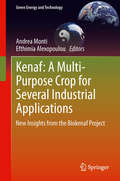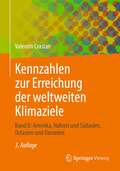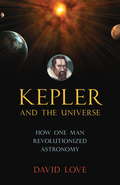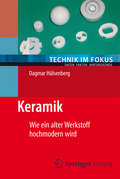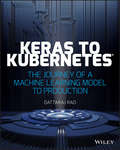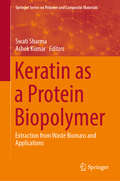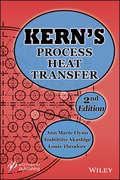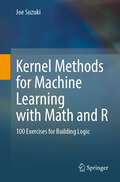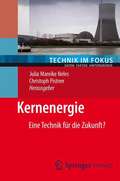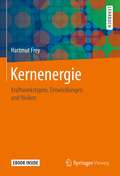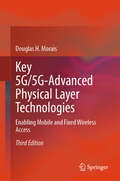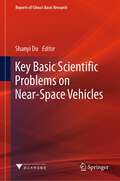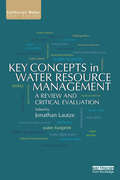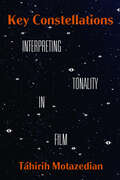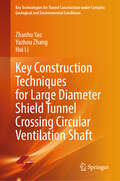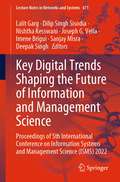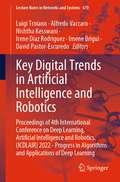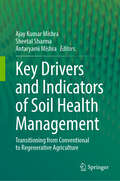- Table View
- List View
Kenaf: A Multi-Purpose Crop for Several Industrial Applications
by Andrea Monti Efthimia AlexopoulouNatural plant fibers fibres are being increasingly used in manufacturing industrial products because of their renewable and biodegradable natures. Kenaf is an annual bast fibre crop that can provide fibres for several industrial applications (composites, insulation mats, absorbents, bedding material, etc.) as well as raw material for energy exploitation (solid biofuels). Kenaf: A Multi-Purpose Crop for Several Industrial Applications introduces the physiology and field management of kenaf, agronomy, productivity, harvesting as well as its the industrial and energy uses of this promising non-food crop. Including recent research collected by the BIOKENAF project, Kenaf: A Multi-Purpose Crop for Several Industrial Applications provides a global picture of state of the art research and developments with Kenaf from Asia, USA and Australia. This thorough introduction if followed up with an assessment of the crops economic viability as well as an the environmental impact assessment of kenaf. Although not a new crop, Kenaf: A Multi-Purpose Crop for Several Industrial Applications provides a comprehensive introduction to this crop and its developing applications for energy engineers, industry managers, politicians and managers working to develop sustainable energy sources and bio-economies.
Kennzahlen zur Erreichung der weltweiten Klimaziele: Band II: Amerika, Nahost und Südasien, Ostasien und Ozeanien
by Valentin CrastanAnalysiert werden die aktuellen Kennzahlen aus der Energiewirtschaft für die geographischen Einheiten Amerika – unterteilt in Nordamerika (Kanada + USA) sowie Mittel- und Südamerika –, Nahost und Südasien sowie Ostasien und Ozeanien. Die wichtigsten energiewirtschaftlichen Indikatoren der einzelnen Regionen und Länder und deren Entwicklung werden in zahlreichen Grafiken und Energieflussdiagrammen veranschaulicht. Darauf basierend empfiehlt der Autor eine Verteilung der zur Begrenzung des Klimawandels notwendigen Emissionsreduktion (für Klimaziel 2 °C und 1,5 °C, mit Perspektive bis 2050).Die in diesem Band behandelten Erdteile verursachen zusammen 77 % der Emissionen. Europa + Eurasien sowie Afrika werden in einem weiteren Band behandelt.
Kenzan Method for Scaffold-Free Biofabrication
by Koichi NakayamaThis is the first book about the “Kenzan” method for scaffold-free biofabrication, which does not rely on biomaterials as scaffolds to ensure correct multicellular spheroid positioning for building three dimensional construct only made from cells. The book explains the basic principles and concepts of the microneedle-based (“Kenzan”) method of building surgically-implantable tissue constructs using robotic cell spheroid-based three-dimensional bioprinting, a novel technology that opens up unique opportunities for the bioengineering of tissues and organs.First book on the novel Kenzan method of tissue engineering;Explains basic concepts and applications for organ regeneration modeling;Introduces a unique robotic system for scaffold-free cell construction.
Kepler and the Universe
by David K. LoveA contemporary of Galileo and a forerunner of Isaac Newton, Johannes Kepler (1571-1630) was a pioneering German scientist and a pivotal figure in the history of astronomy. This colorful, well-researched biography brings the man and his scientific discoveries to life, showing how his contributions were every bit as important as those of Copernicus, Galileo, and Newton. It was Kepler who first advocated the completely new concept of a physical force emanating from the sun that controls the motion of the planets--today we call this gravity and take it for granted. He also established that the orbits of the planets were elliptical in shape and not circular. And his three laws of planetary motion are still used by contemporary astronomers and space scientists. The author focuses not just on these and other momentous breakthroughs but also on Kepler's arduous life, punctuated by frequent tragedy and hardships. His first wife died young, and eight of the twelve children he fathered succumbed to disease in infancy or childhood. He was frequently caught up in the religious persecutions of the day. His mother narrowly escaped death when she was accused of being a witch.Intermingling historical and personal details of Kepler's life with lucid explanations of his scientific research, this book presents a sympathetic portrait of the man and underscores the critical importance of Kepler's discoveries in the history of astronomy.From the Hardcover edition.
Kepler's Witch: An Astronomer's Discovery of Cosmic Order Amid Religious War, Political Intrigue, and the Heresy Trial of His Mother
by James A. ConnorSet against the backdrop of the witchcraft trial of his mother, this lively biography of Johannes Kepler – 'the Protestant Galileo' and 16th century mathematician and astronomer – reveals the surprisingly spiritual nature of the quest of early modern science. In the style of Dava Sobel's Galileo's Daughter, Connor's book brings to life the tidal forces of Reformation, Counter–Reformation, and social upheaval. Johannes Kepler, who discovered the three basic laws of planetary motion, was persecuted for his support of the Copernican system. After a neighbour accused his mother of witchcraft, Kepler quit his post as the Imperial mathematician to defend her. James Connor tells Kepler's story as a pilgrimage, a spiritual journey into the modern world through war and disease and terrible injustice, a journey reflected in the evolution of Kepler's geometrical model of the cosmos into a musical model, harmony into greater harmony. The leitmotif of the witch trial adds a third dimension to Kepler's biography by setting his personal life within his own times. The acts of this trial, including Kepler's letters and the accounts of the witnesses, although published in their original German dialects, had never before been translated into English. Echoing some of Dava Sobel's work for Galileo's Daughter, Connor has translated the witch trial documents into English. With a great respect for the history of these times and the life of this man, Connor's accessible story illuminates the life of Kepler, the man of science, but also Kepler, a man of uncommon faith and vision.
Keramik: Wie ein alter Werkstoff hochmodern wird (Technik im Fokus)
by Dagmar HülsenbergSeit wann kennt man Keramikerzeugnisse? Warum verhalten sich Keramikwerkstoffe im Vergleich zu anderen Werkstoffen völlig anders? Was macht sie so besonders? Wie stellt man sie her? Welche modernen Anwendungen gibt es?Die Autorin gibt Antworten auf diese und weitere Fragen zu einem alten und doch hochmodernen Werkstoff. Sie beschreibt gut verständlich die physikalisch-chemischen Grundlagen, welche die Andersartigkeit von Keramik in Herstellung und Eigenschaften erklären. Und sie geht auf die vielfältigen Anwendungsbereiche ein, sei es in traditionellen Gebieten oder in modernen Anwendungen wie als Katalysatorträger, Dieselpartikelfilter oder in der Energiespeicherung.
Keras to Kubernetes: The Journey of a Machine Learning Model to Production
by Dattaraj RaoBuild a Keras model to scale and deploy on a Kubernetes cluster We have seen an exponential growth in the use of Artificial Intelligence (AI) over last few years. AI is becoming the new electricity and is touching every industry from retail to manufacturing to healthcare to entertainment. Within AI, we're seeing a particular growth in Machine Learning (ML) and Deep Learning (DL) applications. ML is all about learning relationships from labeled (Supervised) or unlabeled data (Unsupervised). DL has many layers of learning and can extract patterns from unstructured data like images, video, audio, etc. Keras to Kubernetes: The Journey of a Machine Learning Model to Production takes you through real-world examples of building DL models in Keras for recognizing product logos in images and extracting sentiment from text. You will then take that trained model and package it as a web application container before learning how to deploy this model at scale on a Kubernetes cluster. You will understand the different practical steps involved in real-world ML implementations which go beyond the algorithms. • Find hands-on learning examples • Learn to uses Keras and Kubernetes to deploy Machine Learning models • Discover new ways to collect and manage your image and text data with Machine Learning • Reuse examples as-is to deploy your models • Understand the ML model development lifecycle and deployment to production If you're ready to learn about one of the most popular DL frameworks and build production applications with it, you've come to the right place!
Keratin as a Protein Biopolymer: Extraction from Waste Biomass and Applications (Springer Series on Polymer and Composite Materials)
by Ashok Kumar Swati SharmaThis book provides information about the sources, structure, and properties of keratin as well as its applications. The extraction from different biomass sources (e.g. feathers, hairs, nails, horn, hoof, and claws) as well as the characterization methods of these extracted materials are explained. The development of bioproducts from keratins is challenging and limited since they are neither soluble in polar solvents nor in non-polar solvents. Therefore, the utilization of different microorganisms for the degradation of keratin is also discussed.The main aim of this book is to highlight the unique features of keratin and to update readers with the possible prospects to develop various value-added products from keratins. The book is highly interesting to researchers working in industry and academia on bioproducts, tissue engineering, biocomposites, biofilm, and biofibers.
Kern's Process Heat Transfer
by Louis Theodore Ann Marie Flynn Toshihiro AkashigeThis book insures the legacy of the original 1950 classic, Process Heat Transfer, by Donald Q. Kern. This second edition book is divided into three parts: Fundamental Principles; Heat Exchangers; and Other Heat Transfer Equipment/ Considerations. - Part I provides a series of chapters concerned with introductory topics that are required when solving heat transfer problems. This part of the book deals with topics such as steady-state heat conduction, unsteady-state conduction, forced convection, free convection, and radiation. - Part II is considered by the authors to be the “meat” of the book – addressing heat transfer equipment design procedures and applications. In addition to providing a more meaningful treatment of the various types of heat exchangers, this part also examines the impact of entropy calculations on exchanger design. - Part III of the book examines other related topics of interest, including boiling and condensation, refrigeration and cryogenics, boilers, cooling towers and quenchers, batch and unsteady-state processes, health & safety and the accompanying topic of risk. An Appendix is also included. What is new in the 2nd edition Changes that are addressed in the 2nd edition so that Kern’s original work continues to remain relevant in 21st century process engineering include:- Updated Heat Exchanger Design- Increased Number of Illustrative Examples- Energy Conservation/ Entropy Considerations- Environmental Considerations- Health & Safety- Risk Assessment- Refrigeration and Cryogenics- Inclusion of SI Units
Kernel Learning Algorithms for Face Recognition
by Jeng-Shyang Pan Jun-Bao Li Shu-Chuan ChuKernel Learning Algorithms for Face Recognition covers the framework of kernel based face recognition. This book discusses the advanced kernel learning algorithms and its application on face recognition. This book also focuses on the theoretical deviation, the system framework and experiments involving kernel based face recognition. Included within are algorithms of kernel based face recognition, and also the feasibility of the kernel based face recognition method. This book provides researchers in pattern recognition and machine learning area with advanced face recognition methods and its newest applications.
Kernel Methods for Machine Learning with Math and Python: 100 Exercises for Building Logic
by Joe SuzukiThe most crucial ability for machine learning and data science is mathematical logic for grasping their essence rather than relying on knowledge or experience. This textbook addresses the fundamentals of kernel methods for machine learning by considering relevant math problems and building Python programs. The book’s main features are as follows:The content is written in an easy-to-follow and self-contained style.The book includes 100 exercises, which have been carefully selected and refined. As their solutions are provided in the main text, readers can solve all of the exercises by reading the book.The mathematical premises of kernels are proven and the correct conclusions are provided, helping readers to understand the nature of kernels.Source programs and running examples are presented to help readers acquire a deeper understanding of the mathematics used.Once readers have a basic understanding of the functional analysis topics covered in Chapter 2, the applications are discussed in the subsequent chapters. Here, no prior knowledge of mathematics is assumed.This book considers both the kernel for reproducing kernel Hilbert space (RKHS) and the kernel for the Gaussian process; a clear distinction is made between the two.
Kernel Methods for Machine Learning with Math and R: 100 Exercises for Building Logic
by Joe SuzukiThe most crucial ability for machine learning and data science is mathematical logic for grasping their essence rather than relying on knowledge or experience. This textbook addresses the fundamentals of kernel methods for machine learning by considering relevant math problems and building R programs. The book’s main features are as follows:The content is written in an easy-to-follow and self-contained style.The book includes 100 exercises, which have been carefully selected and refined. As their solutions are provided in the main text, readers can solve all of the exercises by reading the book.The mathematical premises of kernels are proven and the correct conclusions are provided, helping readers to understand the nature of kernels.Source programs and running examples are presented to help readers acquire a deeper understanding of the mathematics used.Once readers have a basic understanding of the functional analysis topics covered in Chapter 2, the applications are discussed in the subsequent chapters. Here, no prior knowledge of mathematics is assumed.This book considers both the kernel for reproducing kernel Hilbert space (RKHS) and the kernel for the Gaussian process; a clear distinction is made between the two.
Kernenergie
by Julia Neles Christoph PistnerKnapp und klar arbeitet der Autor die Grundlagen zum Verständnis der Kernenergie heraus und ermöglicht Lesern damit einen leichten Einstieg ins Thema. Dabei vermittelt er nicht nur die technisch-wissenschaftlichen Grundlagen in allgemein verständlicher und umfassender Weise, sondern befasst sich auch mit den gesellschaftspolitischen Fragen der Sicherheit, der Entsorgung und der nuklearen Abrüstung. Der Band bietet die Möglichkeit, die aktuellen Entwicklungen nach der Reaktorkatastrophe in Fukushima einzuordnen und zu reflektieren.
Kernenergie: Eine Technik für die Zukunft? (Technik im Fokus)
by Christoph Pistner Julia Mareike NelesKnapp und klar arbeitet der Autor die Grundlagen zum Verständnis der Kernenergie heraus und ermöglicht Lesern damit einen leichten Einstieg ins Thema. Dabei vermittelt er nicht nur die technisch-wissenschaftlichen Grundlagen in allgemein verständlicher und umfassender Weise, sondern befasst sich auch mit den gesellschaftspolitischen Fragen der Sicherheit, der Entsorgung und der nuklearen Abrüstung. Der Band bietet die Möglichkeit, die aktuellen Entwicklungen nach der Reaktorkatastrophe in Fukushima einzuordnen und zu reflektieren.
Kernenergie: Kraftwerkstypen, Entwicklungen und Risiken
by Hartmut FreyDie Nachfrage nach fossilen Brennstoffen steigt stetig an. Zugleich produzieren sie in der Stromgestehung aufgrund der Oxidationsprozesse Kohlendioxid, das dann in die Atmosphäre entweicht und dort als Treibhausgas die Wärmestrahlung adsorbiert und remittiert. Seit geraumer Zeit werden in einigen Ländern neue Kernkraftwerke gebaut. Die weltweite Akzeptanz der Stromerzeugung durch Kernenergie hat durch die Katastrophen von Tschernobyl und Fukushima gelitten, wobei Tschernobyl auf menschliches Versagen beruhte, während die Reaktorblöcke in Fukushima optimal auf Erdbeben ausgelegt waren, nicht aber auf den eines Tsunami. Das Buch fasst den Stand der Technik zusammen, berücksichtigt Beteiligungsprozesse der Öffentlichkeit sowie absehbare Entwicklungen in den Lebensgewohnheiten und politische Vorgaben.
Key 5G Physical Layer Technologies: Enabling Mobile and Fixed Wireless Access
by Douglas H. MoraisThis book covers the key technologies associated with the physical transmission of data on fifth generation (5G) mobile systems. Following an overview of these technologies, a high-level description of 3GPP’s mobile communications standard (5G NR) is given and it is shown how the key technologies presented earlier facilitate the transmission of control data and very high-speed user data. In the final chapter, an overview and the physical layer aspects of 5G NR enabled Fixed Wireless Access (FWA) networks is presented. This book is intended for those practicing engineers and graduate and upper undergraduate engineering students who have an interest in 3GPP’s 5G enabled mobile and or FWA networks and want to acquire, where missing, the necessary technology background in order to understand 3GPP’s physical layer specifications and operation.Provides a comprehensive covering of key 3GPP 5G NR physical layer technologies, presented in a clear, tractable fashion, with sufficient mathematics to make it technically coherent;Addresses all key 5G NR technologies, including digital modulation, LDPC and Polar coding, multicarrier based multiple access techniques, and multiple antenna techniques including MIMO and beamforming;Presents an overview of 5G NR Radio Access Network (RAN) architecture and a detailed understanding of how user and control data is transported in the physical layer by the application of the technologies presented;Provides an overview and addresses physical layer aspects of 5G NR enabled Fixed Wireless Access networks.
Key 5G Physical Layer Technologies: Enabling Mobile and Fixed Wireless Access
by Douglas H. Morais This updated book, reconfigured as a textbook, covers the key technologies associated with the physical transmission of data on 5G mobile systems. Following an updated overview of these technologies, the author provides a high-level description of 3GPP’s mobile communications standard (5G NR) and shows how the key technologies presented earlier facilitate the transmission of very high-speed user data and control data and can provide very low latency for use cases where this is important. In the final chapter, an overview and the physical layer aspects of 5G NR enabled Fixed Wireless Access (FWA) networks is presented. Material in the first edition addressed mainly the key physical layer technologies and features associated with 3GPP release 15, the first release to support 5G. This edition adds descriptions of some of the technological advancements supported in release 16, including integrated access and backhaul (IAB), sidelink communication, NR positioning, operation in unlicensed bands, and multiple transmission points transmission. This textbook is intended for graduate and upper undergraduate engineering students and practicing engineers who have an interest in 3GPP’s 5G enabled mobile and or FWA networks and want to acquire, where missing, the necessary technology background in order to understand 3GPP’s physical layer specifications and operation. The author provides working problems and helpful examples throughout the text.
Key 5G/5G-Advanced Physical Layer Technologies: Enabling Mobile and Fixed Wireless Access
by Douglas H. MoraisThis third edition of this text covers the key technologies associated with the physical transmission of data on 5G mobile systems. Following an updated overview of these technologies, the author provides a high-level description of 3GPP’s mobile communications standard (5G/5G-Advanced) and shows how the key technologies presented earlier facilitate the transmission of very high-speed user data and control data and can provide very low latency for use cases where this is important. In the final chapter, an updated overview and the physical layer aspects of 5G NR enabled Fixed Wireless Access (FWA) networks is presented. Material in the second edition addressed mainly the key physical layer technologies and features associated with 3GPP Release 15, the first release to support 5G, and Release 16. This edition adds descriptions of some of the technological advancements supported in Releases 17 and 18, the latter being designated by 3GPP as 5G-Advanced. In addition to numerous enhancements of existing features, these releases include new features such as support for 1024-QAM in the downlink in the FR1 band, Reduced Capability (RedCAP) devices, Network Controlled repeaters, operation in the 6 GHz band and above 52.6 GHz, support for broadcast/multicast services, and Non-terrestrial Networks (NTNs). Additionally, a look ahead at some of the planned features and enhancements of Release 19 is provided. This textbook is intended for graduate and upper undergraduate engineering students and practicing engineers and technicians who have an interest in 3GPP’s 5G enabled mobile and or FWA networks and want to acquire, where missing, the necessary technology background in order to understand 3GPP’s physical layer specifications and operation. Provided are working problems and helpful examples throughout the text.
Key Basic Scientific Problems on Near-Space Vehicles (Reports of China’s Basic Research)
by Shanyi DuThis book mainly introduces the research overview, research results, and follow-up prospects of “Key Basic Scientific Problems on Near-Space Vehicles”, a major research plan of National Natural Science Foundation of China (hereinafter referred to as the Plan). The Plan is the first systematic basic hypersonic research program in China. From its inception in 2007 to its successful completion in 2016, the Plan lasted nine years, funded a total of 173 projects, and the funding totaled 190 million yuan. From the perspective of major national needs and scientific discipline development, the book focuses on four key scientific issues: aerodynamics in a near-space flight environment; advanced propulsion theories and methods; ultralight materials/structures, thermal environment prediction and thermal protection; and intelligent autonomous control theories and methods for hypersonic vehicles. The book also demonstrates China’s systematic and innovative achievements in interdisciplinary theories and methods and innovative techniques, paving the way for a distinctively Chinese basic research framework and further breakthroughs of near-space hypersonic vehicles.
Key Concepts in Water Resource Management: A Review and Critical Evaluation (Earthscan Water Text)
by Jonathan LautzeThe vocabulary and discourse of water resource management have expanded vastly in recent years to include an array of new concepts and terminology, such as water security, water productivity, virtual water and water governance. While the new conceptual lenses may generate insights that improve responses to the world’s water challenges, their practical use is often encumbered by ambiguity and confusion. This book applies critical scrutiny to a prominent set of new but widely used terms, in order to clarify their meanings and improve the basis on which we identify and tackle the world’s water challenges. More specifically, the book takes stock of what several of the more prominent new terms mean, reviews variation in interpretation, explores how they are measured, and discusses their respective added value. It makes many implicit differences between terms explicit and aids understanding and use of these terms by both students and professionals. At the same time, it does not ignore the legitimately contested nature of some concepts. Further, the book enables greater precision on the interpretational options for the various terms, and for the value that they add to water policy and its implementation.
Key Constellations: Interpreting Tonality in Film (California Studies in Music, Sound, and Media #4)
by Táhirih MotazedianKey is one of the simplest building blocks of music and is among the foundational properties of a work’s musical identity—so why isn’t it a standard parameter in discussing film music? Key Constellations: Interpreting Tonality in Film is the first book to investigate film soundtracks—including original scoring, preexisting music, and sound effects—through the lens of large-scale tonality. Exploring compelling analytical examples from numerous popular films, Táhirih Motazedian shows how key and pitch analysis of film music can reveal hidden layers of narrative meaning, giving readers exciting new ways to engage with their favorite films and soundtracks.
Key Construction Techniques for Large Diameter Shield Tunnel Crossing Circular Ventilation Shaft (Key Technologies for Tunnel Construction under Complex Geological and Environmental Conditions)
by Hui Li Zhanhu Yao Yazhou ZhangBased on the construction of Nanjing Weisan Road Yangtze River Tunnel, this book comprehensively introduces the new technology of large-diameter shield tunnel construction crossing circular air shafts. It focuses on four aspects: the construction technology of super-deep circular air shaft foundation pit retaining structure in the sensitive environment near the river, underwater excavation and underwater massive concrete sealing bottom construction technology, adaptive improvement of TBM and construction technology of crossing air shaft, and control technology of super-deep foundation pit stability during the process of conversion. This book combines theory with practice, and can provide reference for shield engineering construction. It can also be used as a reference for engineering and technical personnel, researchers, teachers and students in related majors in colleges who are engaged in shield tunnel engineering.
Key Digital Trends Shaping the Future of Information and Management Science: Proceedings of 5th International Conference on Information Systems and Management Science (ISMS) 2022 (Lecture Notes in Networks and Systems #671)
by Sanjay Misra Deepak Singh Lalit Garg Nishtha Kesswani Joseph G. Vella Imene Brigui Dilip Singh SisodiaThis book (proceedings of ISMS 2022) is intended to be used as a reference by students and researchers who collect scientific and technical contributions with respect to models, tools, technologies and applications in the field of information systems and management science. This textbook shows how to exploit information systems in a technology-rich management field. The book introduces concepts, principles, methods, and procedures that will be valuable to students and scholars in thinking about existing organization systems, proposing new systems, and working with management professionals in implementing new information systems.
Key Digital Trends in Artificial Intelligence and Robotics: Proceedings of 4th International Conference on Deep Learning, Artificial Intelligence and Robotics, (ICDLAIR) 2022 - Progress in Algorithms and Applications of Deep Learning (Lecture Notes in Networks and Systems #670)
by Alfredo Vaccaro Luigi Troiano Nishtha Kesswani Irene Díaz Rodriguez Imene Brigui David Pastor-EscuredoThe book (proceedings of the 4th International Conference on Deep Learning, Artificial Intelligence and Robotics (ICDLAIR) 2022) introduces key topics from artificial intelligence algorithms and programming organisations and explains how they contribute to health care, manufacturing, law, finance, retail, real estate, accountancy, digital marketing, and various other fields. Although artificial intelligence (AI) has generated a lot of hype over the past ten years, these consequences on how we live, work, and play are still in their infancy and will likely have a significant impact in the future. The supremacy of AI in areas like speech and picture recognition, navigational apps, personal assistants for smartphones, ride-sharing apps, and many other areas is already well established. The book is primarily meant for academics, researchers, and engineers who want to employ AI applications to address real-world issues. The authors hope that businesses and technology creators will also find it appealing to utilise in industry.
Key Drivers and Indicators of Soil Health Management: Transitioning from Conventional to Regenerative Agriculture
by Ajay Kumar Mishra Sheetal Sharma Antaryami MishraThis book explores the crucial transition from conventional to regenerative agriculture practices, focusing on the key drivers and indicators of soil health management. It provides knowledge to implement sustainable agricultural systems that prioritize soil health and foster the transition toward regenerative practices. This book delves into the principles and concepts of soil health, the challenges and limitations of conventional agriculture, the assessment of soil health through various indicators, and the importance of cover crops, crop rotation, conservation tillage, nutrient management, and water conservation practices. It also addresses the role of soil biodiversity, policy frameworks, and scaling up regenerative agriculture, providing practical strategies and case studies. The target audience for this book ranges from students and researchers to policymakers and large-scale farmers. Farmers will benefit from the practical insights and strategies presented, and policymakers and agricultural organizations can gain valuable knowledge on the drivers and policy frameworks supporting sustainable agriculture and soil health management. This book explores the crucial transition from conventional to regenerative agriculture practices, focusing on the key drivers and indicators of soil health management. It provides knowledge to implement sustainable agricultural systems that prioritize soil health and foster the transition toward regenerative practices. This book delves into the principles and concepts of soil health, the challenges and limitations of conventional agriculture, the assessment of soil health through various indicators, and the importance of cover crops, crop rotation, conservation tillage, nutrient management, and water conservation practices. It also addresses the role of soil biodiversity, policy frameworks, and scaling up regenerative agriculture, providing practical strategies and case studies. The target audience for this book ranges from students and researchers to policymakers and large-scale farmers. Farmers will benefit from the practical insights and strategies presented, and policymakers and agricultural organizations can gain valuable knowledge on the drivers and policy frameworks supporting sustainable agriculture and soil health management.
